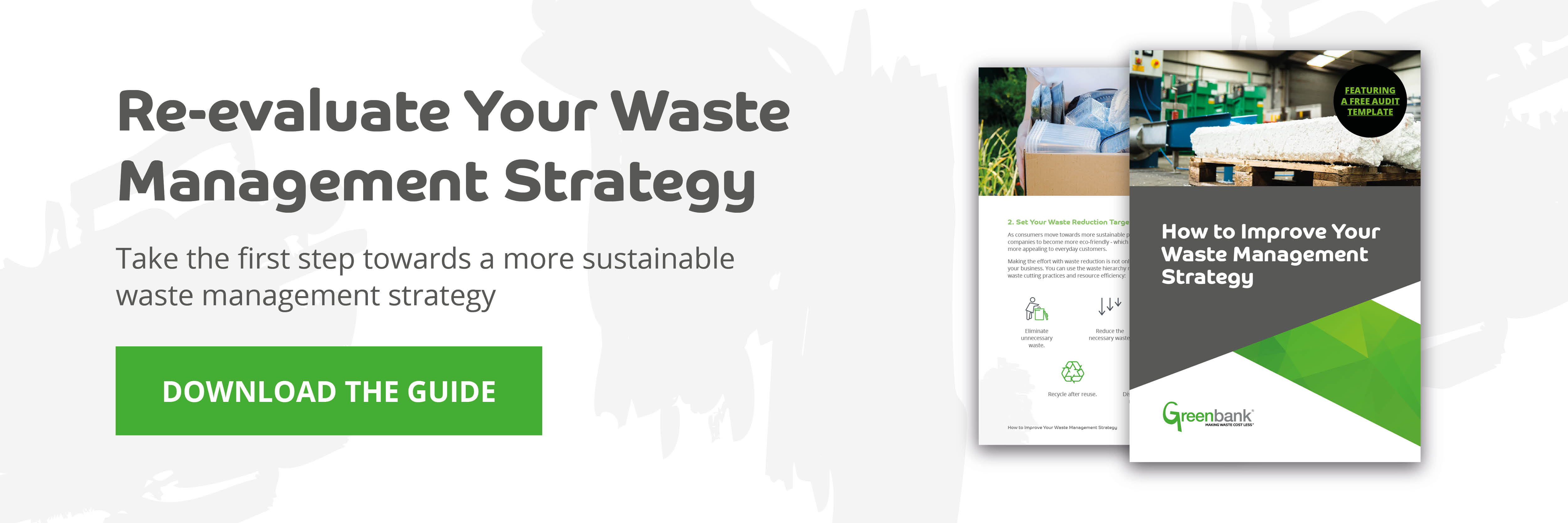Business waste – while it’s an ever-present item and an ongoing byproduct of business processes – it’s never the first thing on people’s minds. This means that waste management processes are, more often than you’d think, not up to standard.
This means that there can be very real risks to your safety, productivity and compliance. Issues with waste management can lie under the surface of your concerns ready to strike at the most inopportune moment.
Ensuring you’re improving your waste management strategy helps to prevent these risks, while also potentially increasing the cost-efficiency of your business by reducing the overheads associated with waste disposal.
So how exactly is this done? Here’s how to improve waste management for businesses.
- Measure Your Waste and Set Goals
- Get To Grips With The Waste Hierarchy
- Discover Your Recycling Options
- Upskill Your Staff Through Training
Measure Your Waste and Set Goals
First of all, measure the individual waste types you’re producing over a given time period. The weight, volume and number of your waste will influence how you can effectively reduce it or streamline how you deal with it.
For example, a large amount of cardboard waste might call for the purchase of a cardboard baler, a machine with the power and capability of baling that specific waste stream. Not only does this make the waste easier to handle and removes it as an obstruction in the workplace, it also reduces the volume of your waste and makes it easier to recycle.
At this point, you can also set objectives. Are you looking to reduce your initial waste production? Reduce the volume of your waste? Lower the presence of safety hazards on-site?
Similarly, you could set goals around proper segregation of waste if you’re having that issue. However, objectives are never one-size-fits-all – you need to approach them from a business-by-business, site-by-site perspective.
If you’re unsure about what objectives are the best options for your specific needs, you can always talk to an experienced waste management solutions provider.
Get To Grips With The Waste Hierarchy
The Waste Hierarchy is part of the EU Waste Framework Directive, providing guidance on how to deal with waste, targeted at any business or public body that happens to generate waste.
Essentially, it covers a process that involves the following stages:
- Prevention
- Preparing for reuse
- Recycling
- Other Recovery
- Disposal
These are ranked by which is best for the environment, with preventing waste production at the top and disposal at the bottom. From an environmental perspective, reducing waste is the greenest option. However, we understand that’s not always possible. In our view, it’s how you deal with that waste that matters.
However, if you are in a position to rework your waste disposal strategy to fit regulations, the Waste Hierarchy does offer many good ideas on what can be done with specific waste. For example, before plastic is disposed of it asks:
- Can it be directly re-used? If not…
- …can it go to closed-loop recycling for eventual re-use? If not…
- …can it go to more general recycling? If not…
- …can it be utilised in energy recovery?
These all come before disposal. Overall, the Waste Hierarchy provides insight on why the solution to waste isn’t one-dimensional. It shouldn’t always be simply ‘thrown away’ – there are other, more effective routes to take.
You can read more on how to apply the Waste Hierarchy in our blog.
Discover Your Recycling Options
Recycling is an incredibly forward-thinking waste disposal choice. It helps the environment in two ways. First of all, waste isn’t going directly to landfill. Secondly, the need for the extraction of raw materials is decreased because still-viable materials make their way back into the supply chain.
However, before you consider recycling, you need to think about availability.
Availability is the recycling capabilities open to you, ones that influence your choices. For example, location, waste amount and waste type have a direct impact on how much you recycle.
Availability is made up of the following factors:
- Regionality: Are there processing facilities close by? Will these take the type and amount of material you’re producing?
- Locality: Are there county-specific recycling programs you can utilise? What sort of waste material collection services are on offer in your area? Are there businesses with which you can pool your waste material in order to cut costs on collections?
- Waste management solution providers: How can these organisations help you determine your best course of action when it comes to recycling? Can they provide you with the right waste machinery, servicing or even small, practical items such as wheelie bins and waste consumables?
Upskill Your Staff Through Training
When it comes to improving your waste management process, staff capability and engagement is key for seeing the kind of results you want.
Without a company-wide insight and understanding of the waste management process you’re undertaking, you’ll experience the obvious – no one will use it. Imagine you’ve purchased a portable compactor for compacting your waste in order to hit both environmental and worker safety objectives, but nobody has been trained on how to use it. This defeats the purpose and ruins the potential ROI of the purchase in the first place.
At the end of the day, everyone in your organisation can make a difference when it comes to a really successful waste management strategy. In some cases, your waste management solutions provider can help to train your employees on their new machinery if needed.
In fact, you can take it further and embody waste management practices within your business as a supplement to company culture, framing them as something intrinsic to a good working environment. Having a real handle on your waste management, framing yourself as an organisation with true care when it comes to environmental compliance – these can even influence how your brand identity develops.
If this blog has piqued your curiosity and you’re looking to learn more in-depth knowledge about improving your waste management, look no further – our guide has all you need.
How to Improve Your Waste Management Strategy
Looking for waste management best practices? Waste audit tips? Info on how best to lay out your site to maximise waste management efficiency? Our guide covers all that and more.
We also cover what to look for in waste management machinery and what to look for in waste management providers – two absolutely necessary considerations when it comes to streamlining your waste production and disposal.
If you’d like to download a copy, simply click the button below.

Industrial Waste Management Solutions
- Retail Waste Management
- Manufacturing Waste Management
- Distribution Waste Management
- Food Packaging Waste Management
Recommended Machinery




